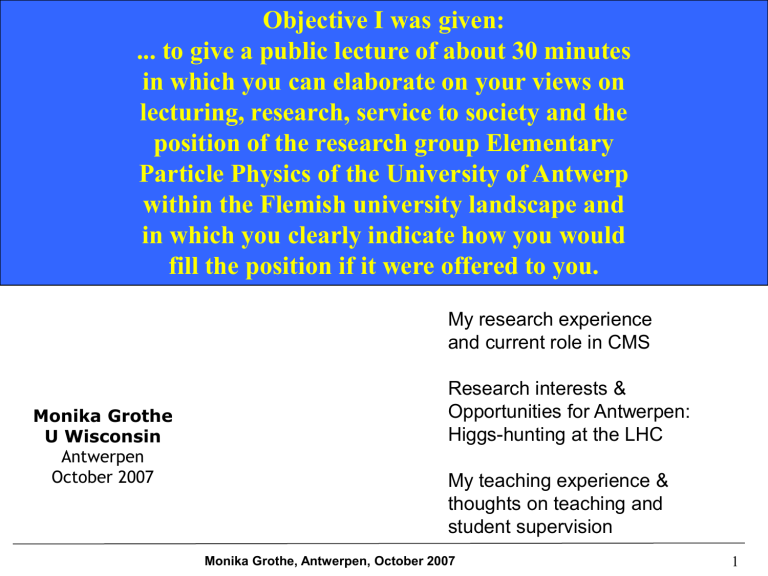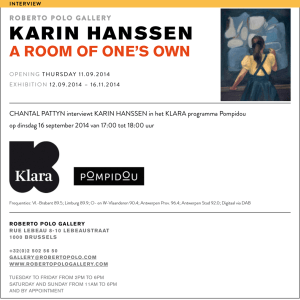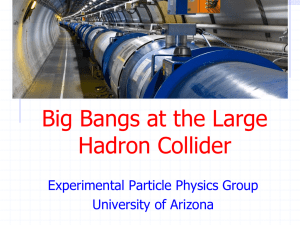Level 1 Calorimeter Trigger

Objective I was given:
... to give a public lecture of about 30 minutes in which you can elaborate on your views on lecturing, research, service to society and the position of the research group Elementary
Particle Physics of the University of Antwerp within the Flemish university landscape and in which you clearly indicate how you would fill the position if it were offered to you.
Monika Grothe
U Wisconsin
Antwerpen
October 2007
My research experience and current role in CMS
Research interests &
Opportunities for Antwerpen:
Higgs-hunting at the LHC
My teaching experience & thoughts on teaching and student supervision
Monika Grothe, Antwerpen, October 2007 1
My research experience
Monika Grothe, Antwerpen, October 2007 2
My research experience: Overall picture
1994 - 1998: PhD thesis University of Bonn, ZEUS, DESY
Diffractive Proton Structure Function measurement
1998 – 2001: Postdoc University of California at Santa Cruz, BABAR, SLAC
Electronics for the Silicon Vertex Tracker (SVT)
SVT run-coordinator
D mixing measurement
2001 – 2003: CERN research fellow, ATLAS, CERN
Software development for High-Level Trigger
Coordinator of HLT muon vertical slice
2004 – 2007: Professore a contratto, U Turin, CMS, CERN
Diffractive Higgs production with CMS
2003 – now: Assistant scientist, U Wisconsin, CMS, CERN
Software development for calorimeter trigger
Commissioning of calorimeter trigger
Trigger studies for
FP420 R&D project
Joint diffractive and fwd physics program with
TOTEM experiment
CMS physics coordinator for diffraction and forward physics
Tried to get to know first-hand all aspects of research at High Energy Physics Experiments
Monika Grothe, Antwerpen, October 2007 3
My current role in CMS
Maintain a close link to the installation and commissioning effort at the experimental site in Cessy (USC55):
Responsibility in integration & commissioning of calorimeter trigger electronics in CMS, in particular, responsible for providing hardware control software as part of overall CMS frameworks
Came to subject of diffraction and fwd physics at the LHC via question of providing a trigger to detect central exclusive production with TOTEM/FP420
(results of my studies included in CMS Physics Technical Design Report)
Attractive about subject:
Provides opportunity for an original contribution to CMS apparatus and to CMS physics program ( FP420 )
Operating TOTEM Roman Pot detectors at 220m together with CMS and detectors at 420m would provide unprecedented kinematic coverage
Program initiated by A. de Roeck, in 2006 took over from him leading the effort of arriving at a joint program with TOTEM
Goal: Make use of diffraction as tool in the Higgs hunt
Monika Grothe, Antwerpen, October 2007 4
My current role in CMS (II)
Maturing of effort:
In December 2006, CMS and TOTEM submitted a document to the
LHC Experiment Committee in which the reach of a joint program on diffraction and fwd physics was described, document and thereby expressed intention of two collaborations to work together positively received by LHCC
I am the principal editor of the CMS/TOTEM document from the CMS side
CMS acknowledged interest of subject for CMS in setting up a dedicated physics analysis group on diffraction and fwd physics (one of eight total)
Since beginning of 2007 I am coordinator of this group, for a two year term
Main objective is preparation for the analysis of the first LHC data
Parallel developments:
CASTOR fwd calorimeter project became official CMS project
Internal refereeing process to make FP420 equally an official CMS project has started, decision by end of the year
Monika Grothe, Antwerpen, October 2007 5
Research interests:
Higgs hunting at the LHC
Monika Grothe, Antwerpen, October 2007 6
Standard Model of particle physics and Higgs Boson
It’s parameters have been measured to very high precision
However, it cannot be the full story:
In the Standard Model, all particles are massless quark masses m g
M
W
M
Z
= 0, m g
= 0
= 80.426 ± 0.034 GeV / c 2
= 91.1875 ± 0.0021 GeV / c 2 proton mass
= 1GeV
Introduce a new field, the Higgs field
Particle acquire mass by moving through it
Monika Grothe, Antwerpen, October 2007 7
The Higgs mechanism -
Spontaneous breaking of electroweak symmetry
Field with two minima
In equilibrium will choose one of the two
2-dimensional field, has 2 eigenstates:
Horizontal excitation: massless mode, no change in potential
Vertical excitation: massive mode, increase in potential proportional to (field) 2
Field (Lagrangian) is left-right symmetric
Ground state is not
Left-right symmetry is said to be spontaneously broken , while in fact symmetry is really hidden
Monika Grothe, Antwerpen, October 2007 8
Interaction with the Higgs field
Prof. D. Miller
UC London
Higgs background field fills space
A particle in the
Higgs field ...
Monika Grothe, Antwerpen, October 2007
... resistance to movement ...
inertia
mass
9
Properties of the Higgs
Supersymmetric Models (SUSY): In the Standard Model:
One complex doublet field, leading to one physical massive Higgs boson with J CP = 0 ++ : H
Properties of the Higgs fully fixed once its mass is known
Quantum-mechanical effects lead to large instabilities in the Higgs mass
Divergencies cancel when one assumes that every SM particle has a superpartner with +1/2 higher spin
From theory only upper limit:
(Unitarity of W
L
W
L scattering)
M(H) < ~1000 GeV
From experiments:
M(H) > 114 GeV @ 95% CL (LEP)
From consistency requirements with electroweak results from LEP, Tevatron:
M(H) < 189 GeV @ 95% CL
SUSY Higgs: Two complex doublet fields, leading to 5 physical Higgs bosons:
2 CP-even neutral ones: h, H
2 charged ones: H
±
1 CP-odd neutral one: A
Monika Grothe, Antwerpen, October 2007 10
LHC discovery potential for a SM Higgs
ATLAS + CMS
10 fb -1
1 fb -1
0.1 fb -1
~ 5 fb -1
~ < 1 fb
J.J. Blaising et al, Eur. Strategy workshop
-1 needed to achieve a 5 s discovery needed to set a 95% CL limit
Hunt for the Higgs will employ a number of Higgs production and decay channels
After discovery: program of measuring Higgs quantum numbers and couplings
Monika Grothe, Antwerpen, October 2007 11
LHC discovery potential for SUSY Higgs
“LHC wedge region”:
Heavy SUSY Higgs bosons decouple from W, Z
Can no longer use well-developed Higgs detection methods that work for all other regions
SUSY parameter space traditionally described as 2-dimensional plane: tan
= (ratio of vacuum expectation values of 2 Higgs fields) versus m(A)
(mass of the CP-odd Higgs boson)
Full coverage of SUSY Higgs parameter space at LHC
Monika Grothe, Antwerpen, October 2007 12
The LHC: A machine to find the Higgs
French Alps
Geneva
Lake Geneva
French Jura Mts
7 TeV
Monika Grothe, Antwerpen, October 2007
7 TeV
13
Getting ready for first data in 2008
Expected in 2008: Integrated Lumi < 1fb -1
On 26 April 2007, the last superconducting magnet for the LHC was lowered into the accelerator tunnel.
Lowering of part of the muon detection system into the CMS experimental cavern in February 2007
First LHC data taking foreseen in 2008
Emphasis now on getting ready for analyzing the first LHC data
Monika Grothe, Antwerpen, October 2007 14
Opportunities in the Higgs hunt at the LHC
Building on existing expertise in Antwerpen:
Discovery of a light charged SUSY Higgs
Standard Model Higgs discovery channel: H->WW*
Benefit of CMS fwd calorimeter CASTOR for the Higgs hunt
Hunting the Higgs in central exclusive production with FP420
Monika Grothe, Antwerpen, October 2007 15
Light SUSY H
Statement from Higgs group
2007/8 planning meeting
Excess might be observable already with a few fb -1
Monika Grothe, Antwerpen, October 2007 16
Light SUSY H
Monika Grothe, Antwerpen, October 2007 17
Inclusive SM Higgs production with H->WW*
Two most important production channels
Higgs boson likes mass
Decays preferably into the heaviest particle kinematically possible
Discovery potential already with ~1fb for M(H) ~ 2M(W)
-1
Vector-Boson Fusion
Monika Grothe, Antwerpen, October 2007
VBF channel could profit from CASTOR calorimeter
18
VBF SM Higgs production with H->WW*
May profit from CASTOR which extends detector coverage to angles smaller than 1 o
Tag jets
Contributes significant discovery potential
In addition, may provide evidence for spin-0 Higgs, leptons prefer small
1 o 10 o 90 o
(non-linear scale)
170 o 179 o
Higgs
Decay
Monika Grothe, Antwerpen, October 2007 19
Benefits from Castor calorimeter for Higgs
Extends CMS calorimetric coverage in the very fwd direction, to below 1 o wrt beam axis
W
Monika Grothe, Antwerpen, October 2007
Benefits for Higgs searches:
Provides handle on effect of underlying events/multiple parton-parton interactions
Use in Vector Boson Fusion channels for detecting forward tag jets
20
Central exclusive Higgs production & FP420
shields color charge of other two gluons
Vacuum quantum numbers
“Double Pomeron exchange” pp
pHp with H (120GeV) -> bb
In non-diffractive production hopeless, signal swamped with QCD dijet background
Selection rule in CEP (central system is J PC = 0 ++ to good approx) improves S/B for SM Higgs dramatically
In particular beneficial for SUSY Higgs:
Production cross section considerably higher than for SM
May allow discovery of heavy SUSY Higgs bosons in
LHC wedge region
CP quantum numbers & CP violation in Higgs sector directly measurable from azimuthal asymmetry of protons beam p’ detector dipole dipole p’ detector
Proton spectrometer using the LHC beam magnets:
Detect diffractively scattered protons inside of beam pipe
Monika Grothe, Antwerpen, October 2007
FP420 is an R&D project that proved the feasibility of putting proton detectors at 420m from the IP
Decision whether FP420 will be built in CMS expected by end of 2007
21
My activities in Higgs physics so far
My involvement in Higgs physics at the LHC so far via FP420:
Question of using forward detectors in the CMS trigger for pp->pHp with H->bb
Studies carried out together with Richard Cross (Bristol PhD student)
Results included in CMS Physics Technical Design Report
Trigger tables there foresee for the first time a dedicated fwd detectors trigger stream
Question of impact of pile-up on the selection with forward proton tags for central exclusive production of pp-> pHp with H-> bb and H-> WW*
Studies carried out with Marek Tasevsky (Antwerpen, now Prague)
Results included in the CMS/TOTEM document
Studies caused a dedicated effort on developing methods to fight pile-up impact
Analysis of pp-> pHp with H-> WW*
Studies carried out with Antonio Vilela Pereira (U Turin PhD student)
22 Monika Grothe, Antwerpen, October 2007
Teaching
Monika Grothe, Antwerpen, October 2007 23
My teaching experience
Student supervision and tutoring:
It’s something I enjoy, though because of my type of position I cannot be officially named PhD advisor.
Richard Croft (PhD student Bristol):
Was his supervisor during his 1-year stay at CERN
Worked with me on defining a forward detectors trigger stream
This work forms an essential part of his PhD thesis
Results were presented by him at an international conference, they are included in two official CMS publications (Physics TDR and CMS/TOTEM document)
Worked on diffractive heavy flavor production with two students from Brazil during their 2-months stay at CERN.
Led their work to point that their results could be included in CMS/TOTEM document
Dilson de Jesus Damiao returns to CERN for a 1-year stay this October
I was asked by his advisor to act as his supervisor during his stay.
Antonio Vilela Pereira decided to take up a PhD in Turin a year ago (where at the time I was a fixed term professor) to work with me
In addition contributed to the scientific supervision of Fredrik Oljemark (Helsinki) and Creighton Hogg (Wisconsin)
Monika Grothe, Antwerpen, October 2007 24
My teaching experience (II)
Formal teaching and lecturing:
30 hour course on CP violation and mixing in Turin
Defined course concept and content myself:
Course had 2 parts:
1. Lectures
2. Student seminar talks
Since textbook on subject are largely outdated tried to base my lectures on up-to-date material from my time in BaBar
Students with guidance from me prepared seminar talks on some of the first BaBar papers contributed to a conference
Graduate from textbooks to scientific papers
Student gave talks in front of “friendly” audience of their fellow-students
The art of giving talks
25 Monika Grothe, Antwerpen, October 2007
Some thoughts on teaching
Disclaimer: I have no first-hand experience with Belgian Universities
Found the blackboard an ideal teaching tool
Tried to get students as much as possible in contact not just with the “what” but also the “how”, i.e. the scientific culture
Well designed and maintained lab courses are essential, opportunities “to play”
To attract Master’s and PhD students to ones group, offering little “get-to-know” projects can be useful, e.g. 2 weeks spent in research group during semester breaks
Teaching beginners appears to be a special challenge, problem of smoothing the transition between the strictly structured environment at schools and the self-guided and self-motivated studying at university, not sure if making university more school-like is the answer
Teaching physics to non-physicists also more challenging, need to make material relevant to students and go beyond physics jargon
Outreach activities important
26 Monika Grothe, Antwerpen, October 2007
Last words
Attracting students by offering a strong research program at one of the foremost experimental facilities in the world in a stimulating international setting
Possibilities:
Discovery of a light charged SUSY Higgs
Standard Model Higgs discovery channel: H->WW*
Benefit of CMS fwd calorimeter CASTOR for the Higgs hunt
Hunting the Higgs in central exclusive production with FP420
Monika Grothe, Antwerpen, October 2007 27
My research experience: What I learnt
1994 - 1998: PhD thesis University of Bonn, ZEUS, DESY
Physics of calorimetric detectors
Diffractive physics resulted in
Issues in measuring a structure function ZEUS publ.
Issues in analysing data from movable near-beam detectors on F2D4
1998 – 2001: Postdoc University of California at Santa Cruz, BABAR, SLAC
Developing electronics
Leading an installation team
Silicon detector physics
Commissioning a Silicon Vertex Detector, radiation protection issues resulted in NIM paper on first-year experience with SVT
Physics of mixing & CP violation
Issues in a lifetime analysis, detector alignment issues resulted in BaBar prelim result shown at conferences
2001 – 2003: CERN research fellow, ATLAS, CERN
Writing decent object oriented C++ software
Functioning of a software-based High Level trigger
Coordinating a team of software developers
Tried to get to know first-hand all aspects of research at
High Energy Physics Experiments
Monika Grothe, Antwerpen, October 2007 28
Mathematical inconsistency of SM
Monika Grothe, Antwerpen, October 2007 29
Supersymmetry
Monika Grothe, Antwerpen, October 2007 30
SUSY
Monika Grothe, Antwerpen, October 2007 31
Production of SM Higgs Boson
Monika Grothe, Antwerpen, October 2007 32
Higgs Boson Production at Hadron Colliders
( i) Gluon fusion (ii) Vector boson fusion
(iii) Associated production (W/Z, tt)
Monika Grothe, Antwerpen, October 2007 33
Properties of the Higgs Boson
• The decay properties of the Higgs boson are fixed, if the mass is known:
W + , Z , t, b , c,
+
,..........., g, g
H
W , Z , t, b , c,
-
,.........., g, g
W +
W g g
Higgs boson likes mass:
It couples to particles proportional to their mass
→ decays preferentially in the heaviest particles kinematically allowed
34 Monika Grothe, Antwerpen, October 2007
Higgs Discovery channels
Monika Grothe, Antwerpen, October 2007 35
Higgs Discovery channels
Monika Grothe, Antwerpen, October 2007 36
Current limits on the Higgs
Monika Grothe, Antwerpen, October 2007 37
Layout of CMS
MAGNET COIL
ELECTROMAGNETIC
CALORIMETER
PRESHOWER
DETECTOR IRON YOKE
SILICON STRIP
TRACKER
HB
HE
PIXEL
DETECTOR
HADRON CALORIMETER
BARREL MUON
CHAMBERS (DT+RPC)
Monika Grothe, Antwerpen, October 2007
ENDCAP MUON
CHAMBERS (CSC+RPC)
HF
VERY-FORWARD
CALORIMETER
38
Title
Monika Grothe, Antwerpen, October 2007 39
VBF: Forward jet tagging
Rapidity distribution of tag jets Rapidity separation
VBF Higgs events vs. tt-background tt
Higgs
Higgs tt
Monika Grothe, Antwerpen, October 2007 40
ATLAS
VBF
qq H
qq W W*
qq ℓ ℓ
CMS
Transverse mass distributions: clear excess of events above the background from tt-production
Monika Grothe, Antwerpen, October 2007 41
VBF
Presence of a signal can also be demonstrated in the
distribution
(i.e. azimuthal difference between the two leptons)
Evidence for spin-0 of the Higgs boson
Spin-0 → WW → ℓ ℓ expect leptons to be close by in space signal region
Monika Grothe, Antwerpen, October 2007 background region
42





